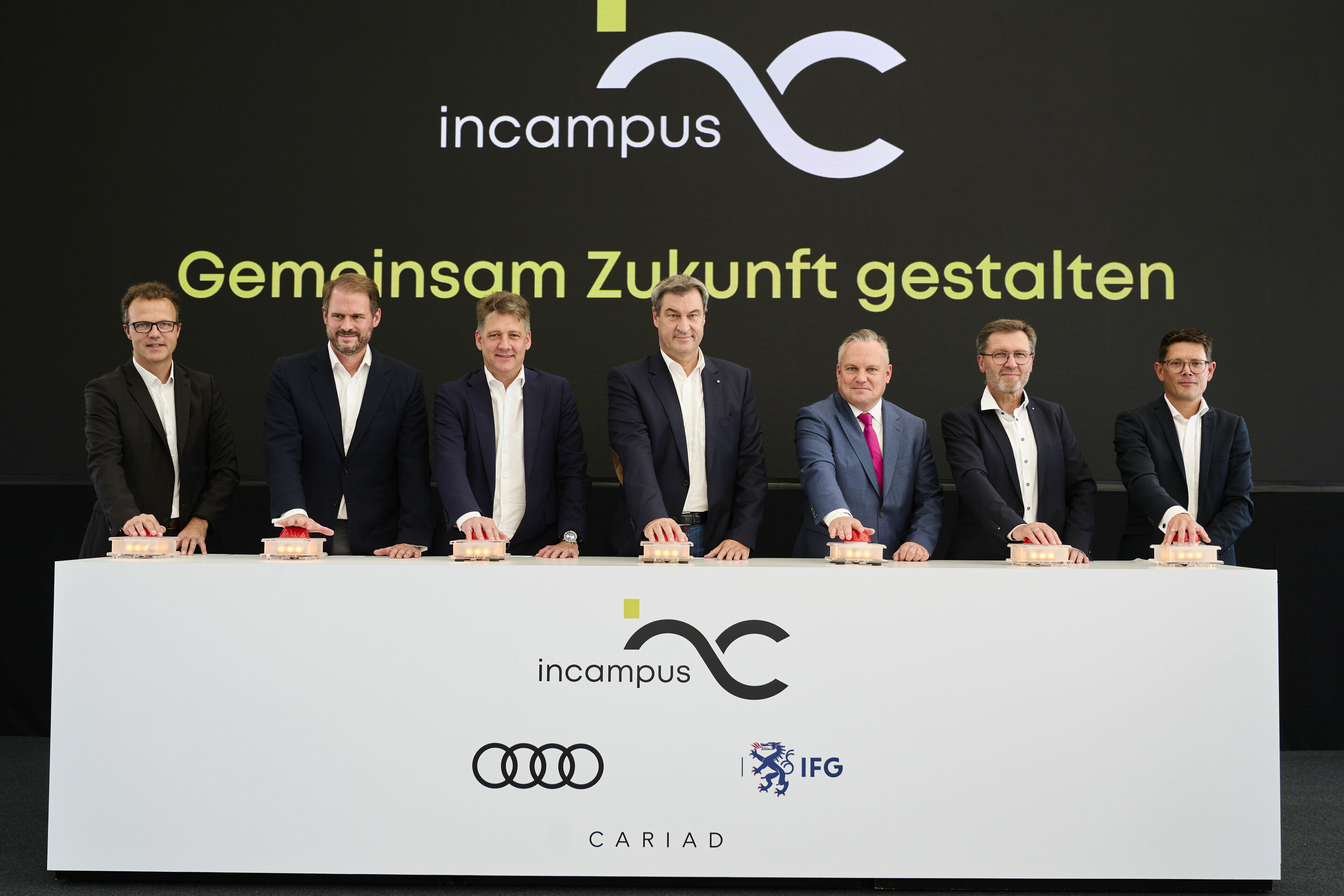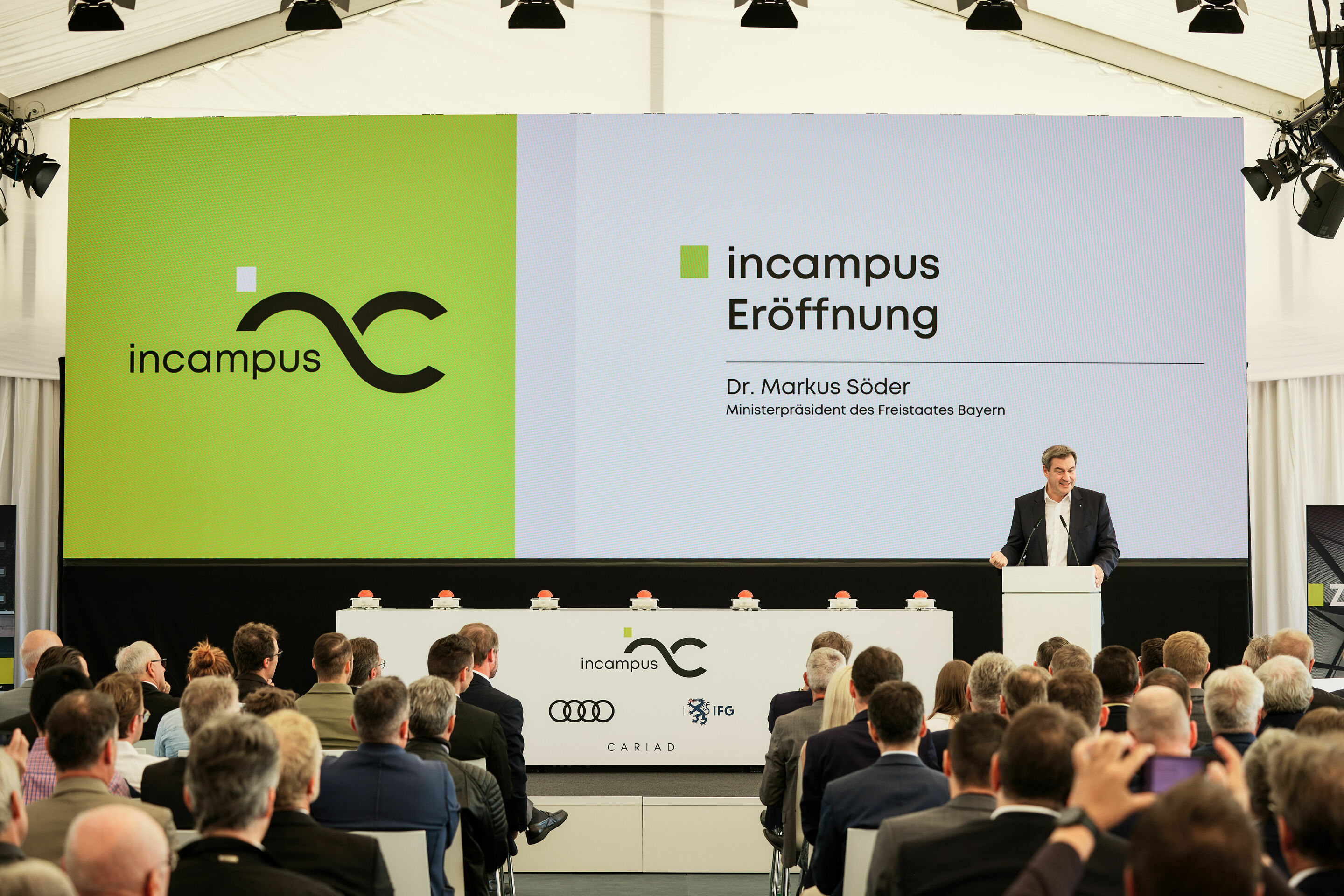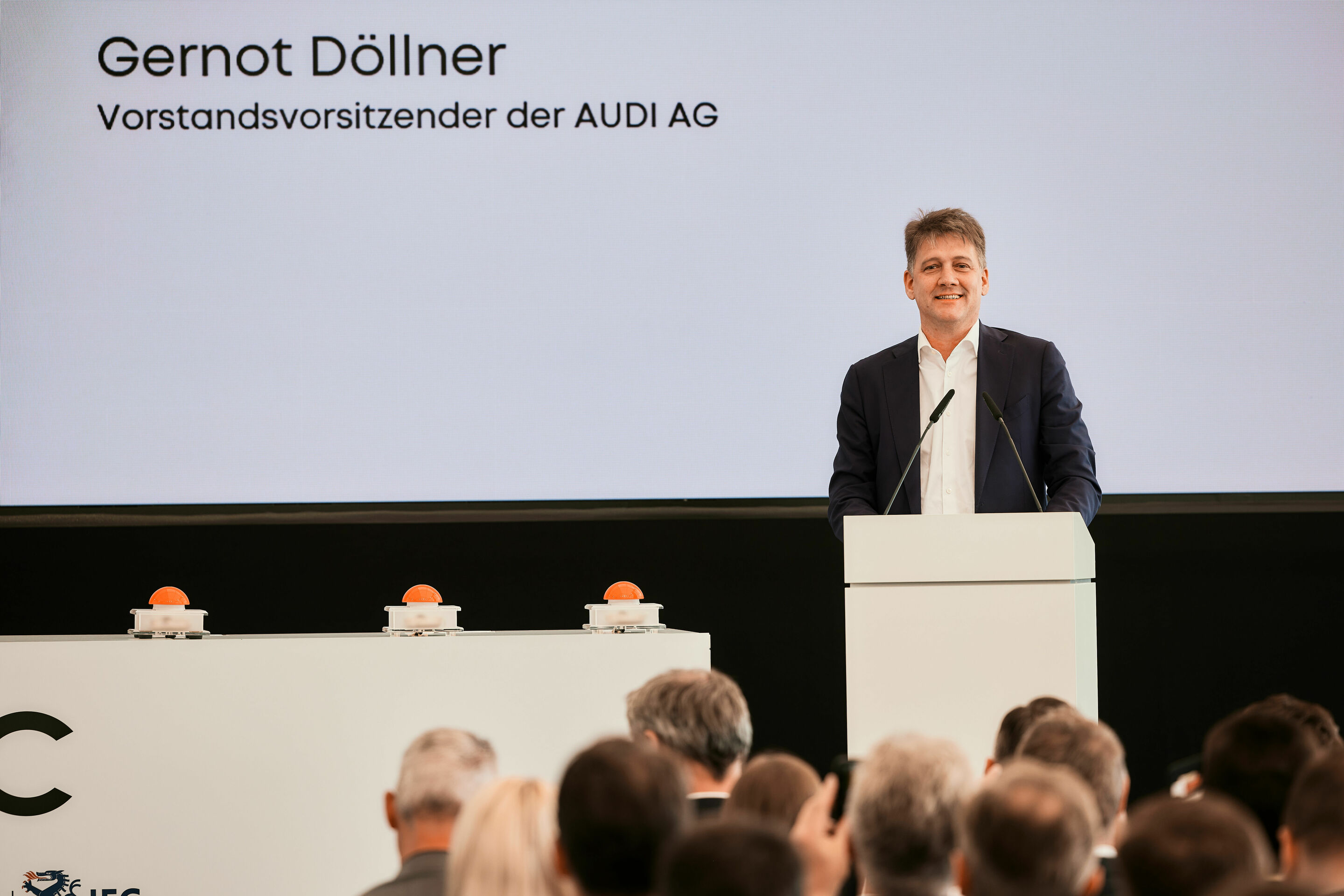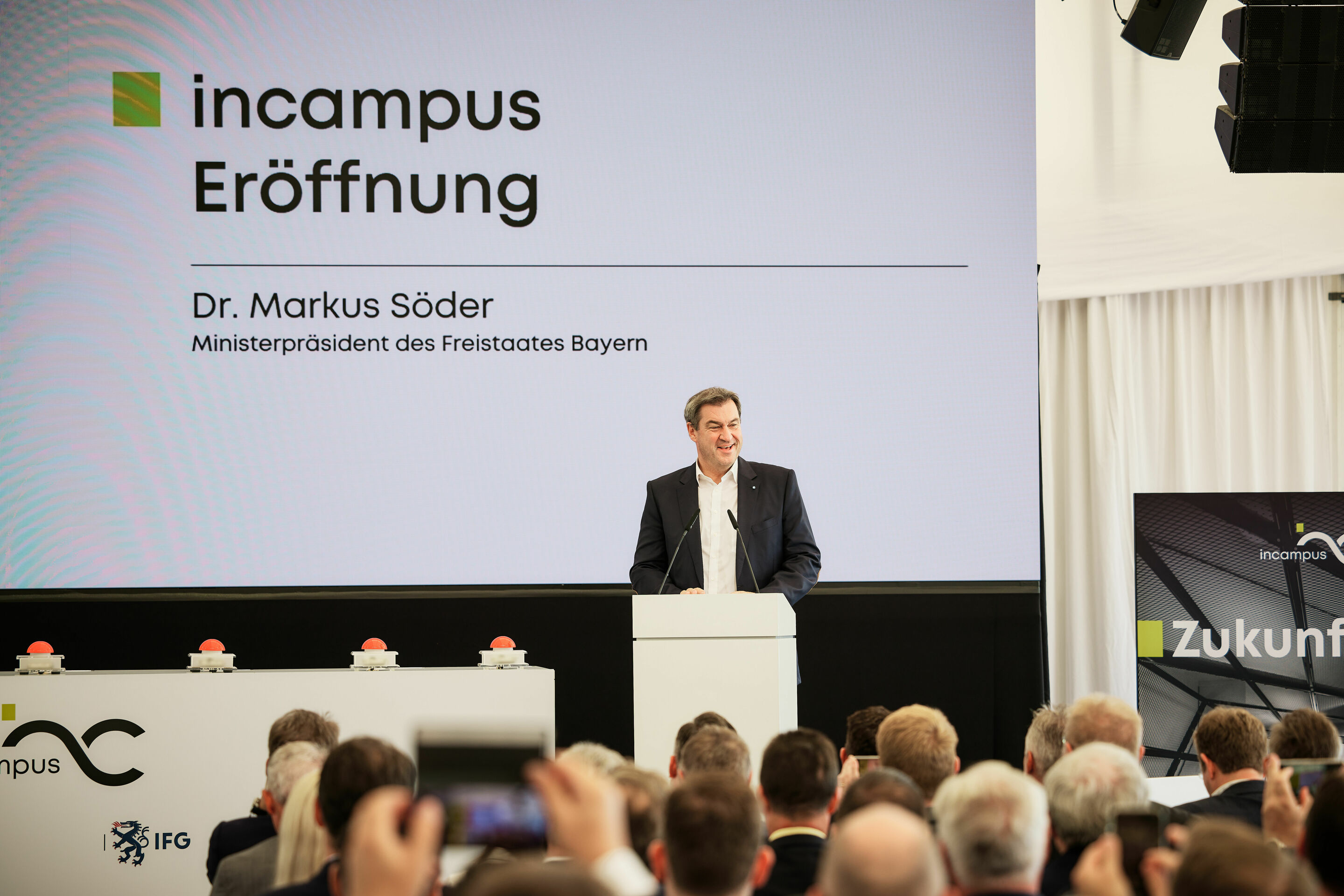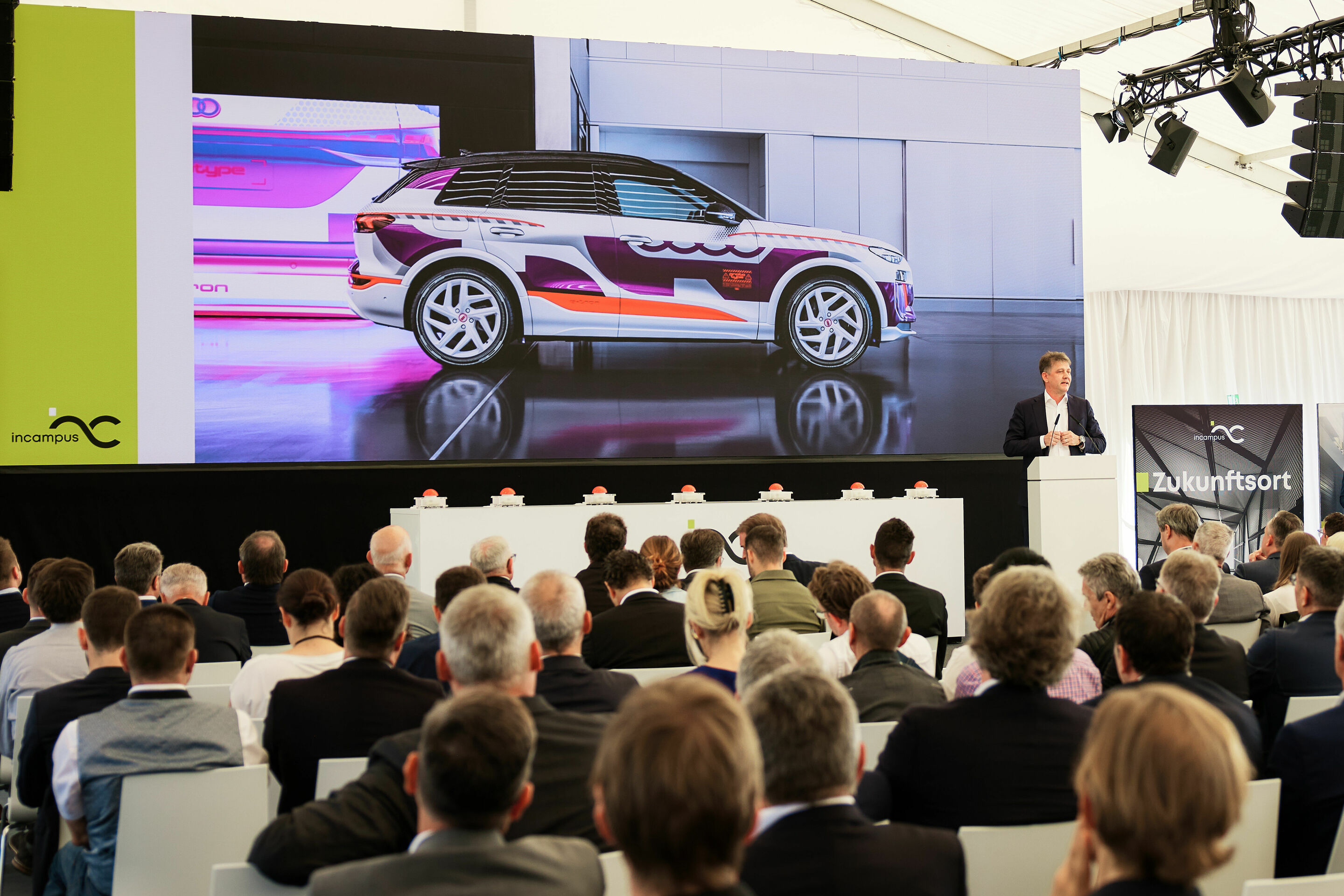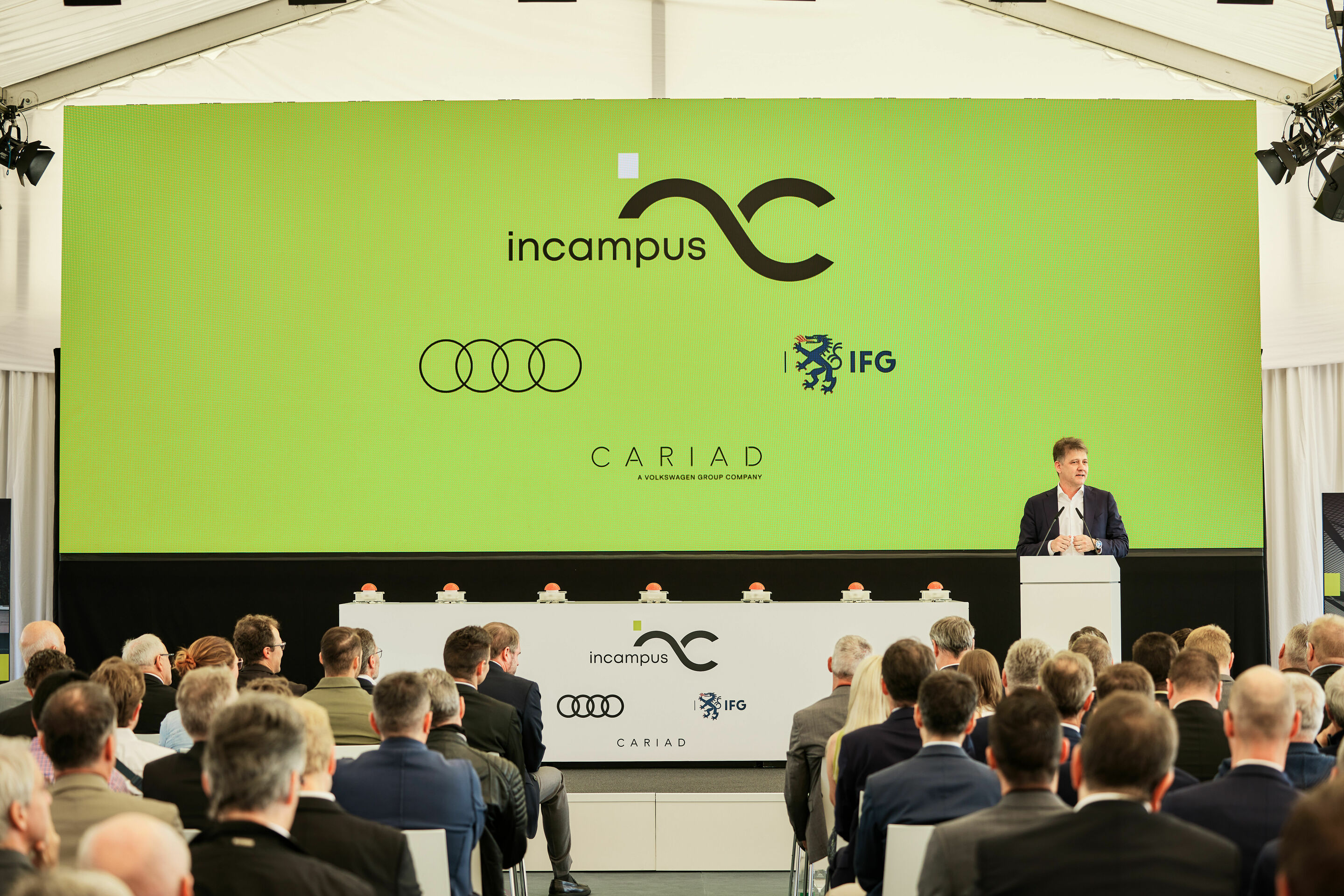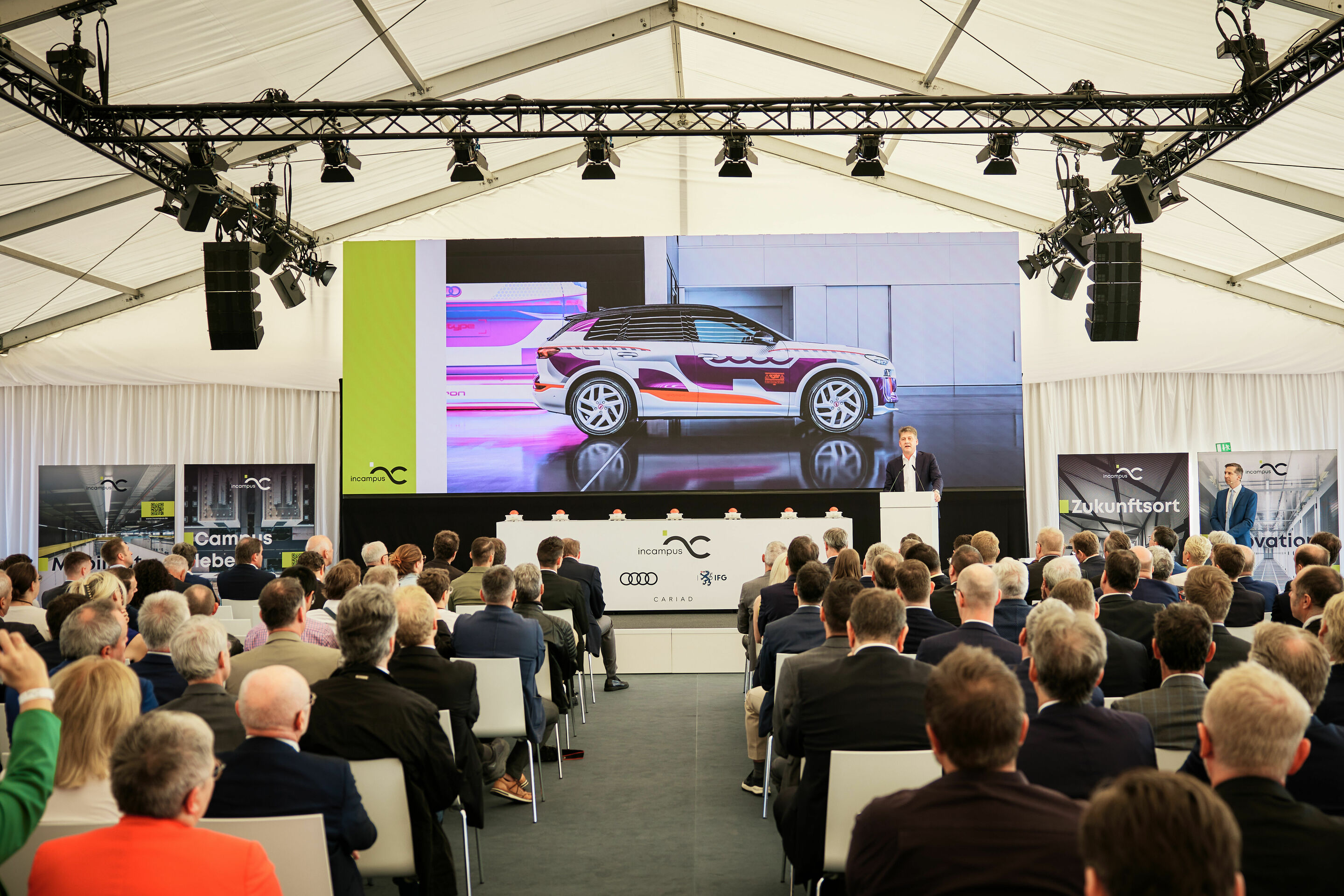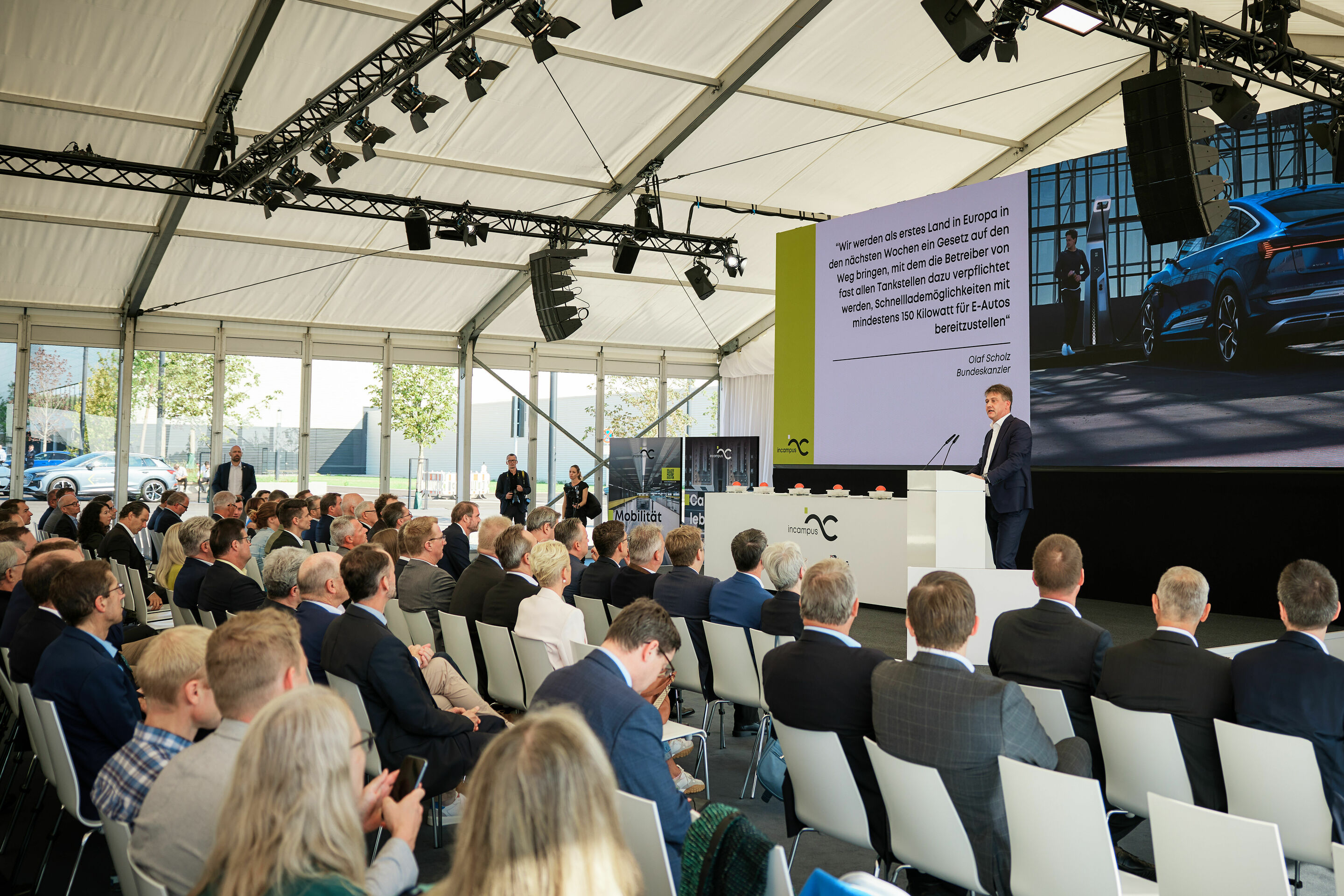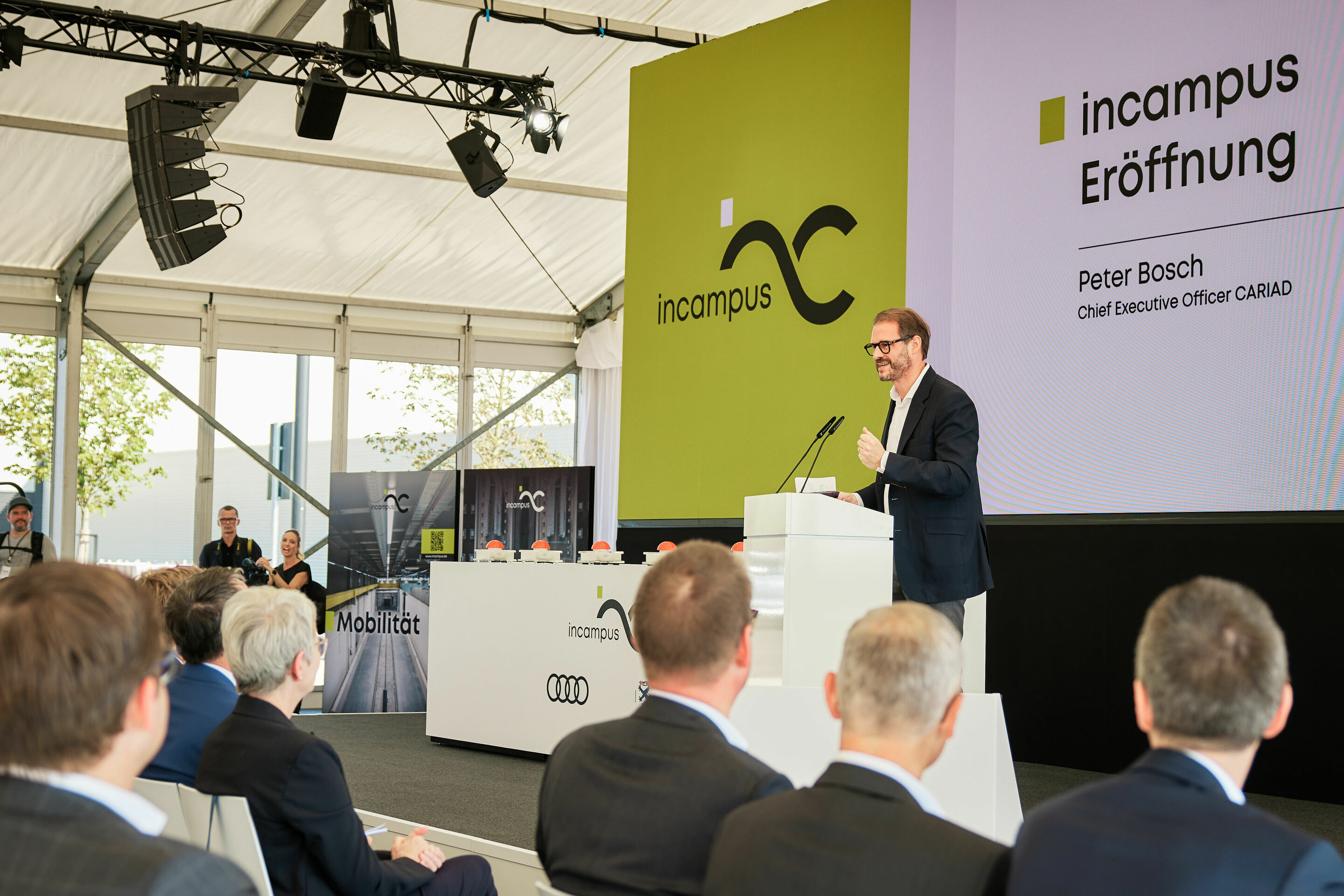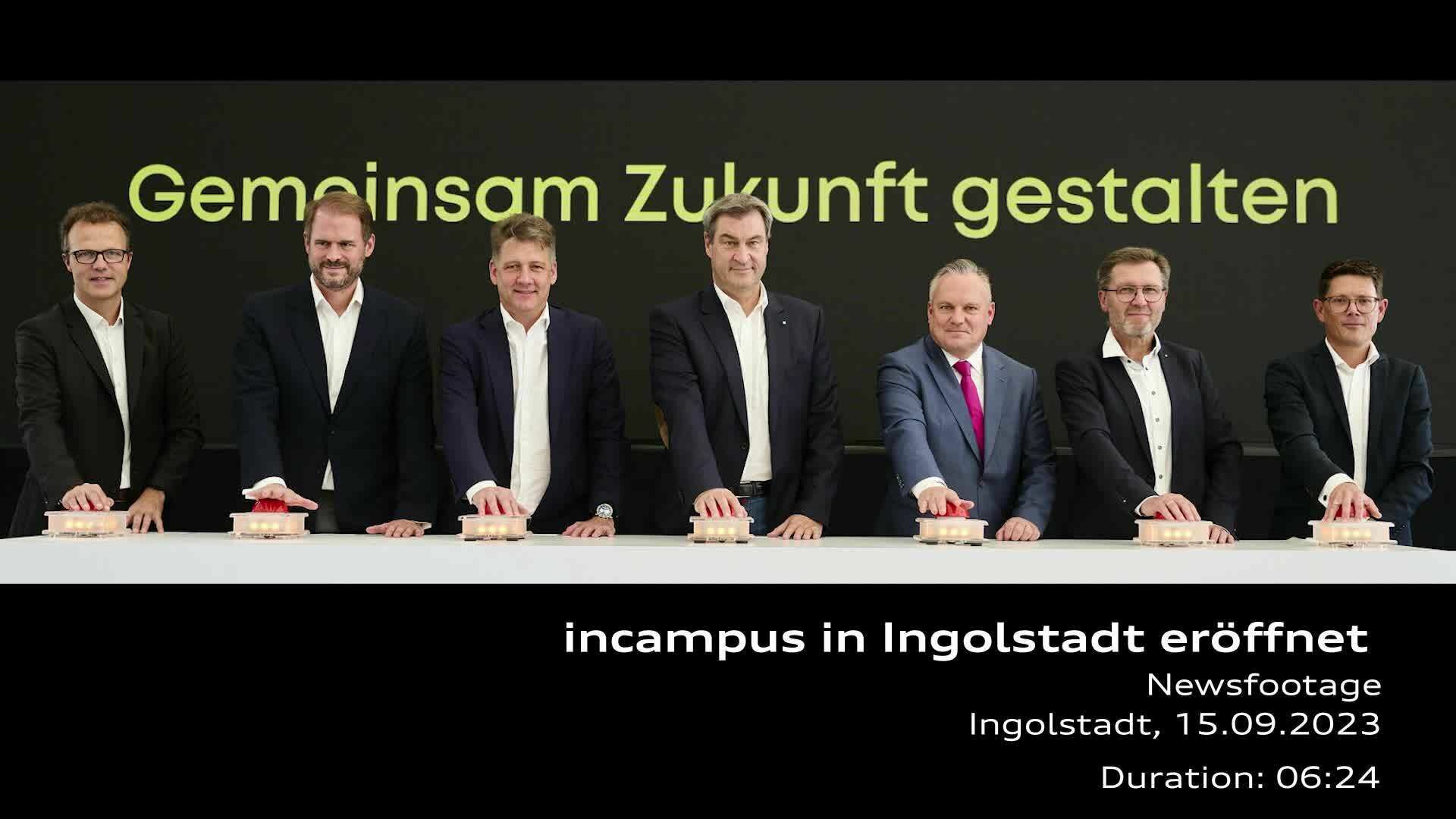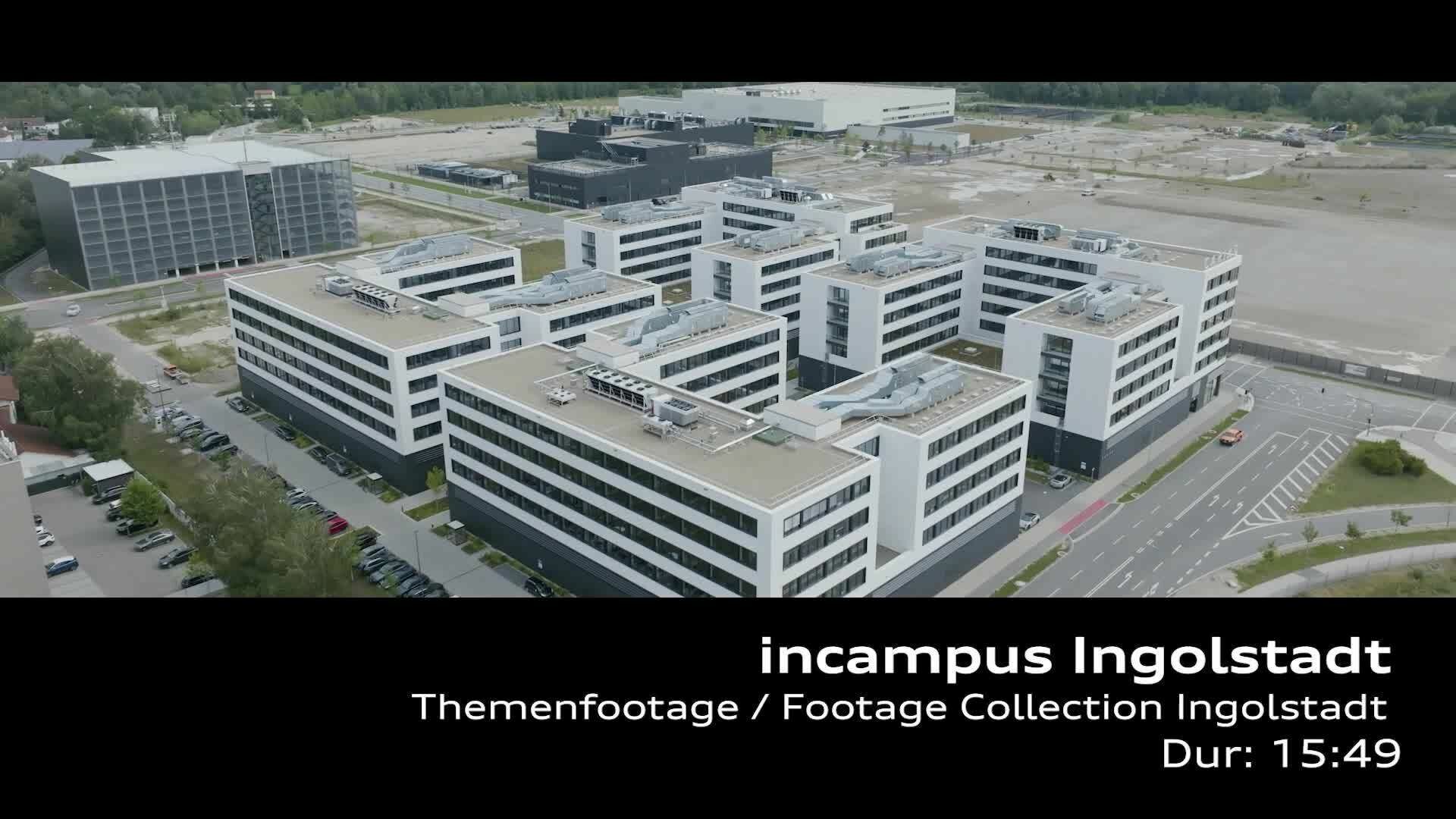incampus opens in Ingolstadt: Ground for new ideas
- Official opening of the incampus after seven years of soil remediation and development
- Modern technology park with a sustainable energy concept offers space for projects ranging from an IT Center to a Vehicle Safety Center
- Joint venture between Audi and the city allows for a unique transformation story and advances development of the site
After seven years of extensive soil remediation and construction, the time has come. The official opening of the incampus technology park was attended by Minister-President of Bavaria Markus Söder and Mayor of Ingolstadt Christian Scharpf. On the former refinery site, Audi and its partners will work on the future of mobility. Audi already has a new Vehicle Safety Center and an IT Center at the site, and the Volkswagen Group’s software company CARIAD also has its biggest tech hub there.
IN-Campus GmbH is a joint venture between the City of Ingolstadt, through its holding company IFG AöR, and AUDI AG. It created a technology park that’s already being used by the VW software company CARIAD and the Technische Hochschule Ingolstadt, among other companies. With the official opening of the incampus, Audi is also celebrating the inauguration of its new Vehicle Safety Center on the site. The company’s new IT Center on the incampus started operations back in 2022. Space for more companies and institutions will be opened up in subsequent construction phases.
At the opening ceremony, the technology park was officially inaugurated by Minister-President of Bavaria Markus Söder, Mayor of Ingolstadt Christian Scharpf, Audi CEO Gernot Döllner and CARIAD CEO Peter Bosch. "With the opening of the incampus in Ingolstadt, a modern innovation and technology center for mobility has been created at a former refinery. Science, research, innovation, and ecology come together here," said Minister-President Söder.
“The constant change in our city can be seen at the incampus. Innovation and the future are being created at the former refinery site – and with them, new innovative jobs. I’m also pleased that we were able to restore substantial areas to nature after the remediation. This successful cooperation between business and municipality in the remediation and development of the site is exemplary. The incampus is a major win for Ingolstadt,” Mayor Scharpf said. For Audi, too, this collaboration with the city may serve as a role model for other regions. “To shape the future of mobility, Audi needs strong partners and cooperation between politics and business. With the incampus, we’re creating the preconditions to bolster regional value creation and to work with partners like CARIAD on concrete solutions for our vision of the future of mobility,” Gernot Döllner said, adding that Audi is creating modern jobs in places like the new Vehicle Safety Center.
The Vehicle Safety Center
The biggest building on the incampus premises is the new Vehicle Safety Center. It measures 130 by 260 meters with runways. When designing the facility, particular attention was paid to allowing for opportunities for developments. For instance, there’s an integrated crash arena in a pillar-free space of 50 by 50 meters. The crisscrossing crash lanes there enable test configurations that include vehicle-on-vehicle collisions. The longest runway is 250 meters long, allowing tests in crash situations with preceding braking interventions.
A fixed crash block and a mobile crash block with four impact sides allow for efficient operation. This makes it possible for significantly more complete vehicle crash tests to be carried out every year than in the previously used crash hall on Audi’s plant premises in Ingolstadt. The new Vehicle Safety Center also offers the approximately 100 employees on site a variety of additional testing facilities for systems, bodies and components.
More information about the new Vehicle Safety Center can be found here.
The IT Center
A new Audi IT Center was built near the Vehicle Safety Center. With a floor space of nearly 10,000 square meters, it supports AUDI AG’s future projects with state-of-the-art hardware and software. Around 800 servers and data storage units are available there on an area of 2,400 square meters. Its potential output in its first expansion stage is around two megawatts, and this can be increased to 4.4 megawatts. In the IT Center’s technical concept, maximum availability, the highest level of failure safety and energy efficiency are the top priorities. For instance, thanks to a novel concept, the waste heat from the servers flows into the incampus’s overall energy supply network and can be used to heat other locations at the site. This transforms the IT Center from a consumer of energy into a generator.
Software skills and digitalization at the incampus
One distinctive building at the incampus is the so-called project house: a four-building complex in the northwest of the site. Its 42,000 square meters of office and workshop space are fully rented out.
CARIAD has had a tech hub at the incampus since the end of 2020. The site is home to the software company’s largest location. More than 2,000 CARIAD employees work there on tech stacks for all Volkswagen Group brands, including the development of the digital driving experience, automated driving, tech platforms and cloud services.
One highlight of the incampus is that CARIAD is developing the premium software and electronics architecture for the Audi and Porsche models based on the new Premium Platform Electric (PPE) there. “At the incampus, CARIAD and Audi are working together on software that will represent a competitive edge for the Group,” said Peter Bosch, CEO of CARIAD. “Together with Audi and Porsche, we’re developing the 1.2 electronics architecture here, the Volkswagen Group’s most important software architecture of the coming years. We’re utilizing modern work processes and tools for close collaboration and higher speed.”
The Automated Driving Alliance, in which CARIAD and its partner company Bosch are working together to develop automated driving functions, is also located there.
The modern offices there have flexibly selectable workplaces and are designed in a way to promote agile work and team exchange. In extensive workshops and laboratories, CARIAD developers are working on advancing the integration of software in vehicles from Audi and other Group brands.
A two-story functional building is located in the northeast of the incampus. There, the Technische Hochschule Ingolstadt installed its control center for the IN2Lab project, a digital test field for automated and connected driving, in which Audi is involved as a project partner. This functional building also contains training rooms, a dedicated fire station for the incampus and property protection facilities. The incampus has a direct connection to highway A9. A section of this highway has served as a digital testing area for the development of automated driving for years. This testing area has been expanded to the incampus via Auwaldseestraße.
The innovative energy supply concept
The incampus is designed for the best possible energy efficiency and is meant to become a zero-energy campus. While the technology park currently obtains green energy externally, the site will generate as much renewable energy as it consumes in the future. Measures to that end include waste heat utilization, energy storage and intelligent control systems. The incampus’s modular energy concept is based on three basic components: a water-based piping system, reversible heat pumps and a cross energy concept. With the piping network and reversible heat pumps, buildings on the incampus are heated with waste heat from other buildings, like the IT Center. This saves energy, and energy that otherwise wouldn’t be used gets upcycled.
The groundwater treatment system on the incampus premises also utilizes heat. The ten wells’ electric pumps draw polluted groundwater out of the soil. But before it seeps away elsewhere after treatment, this water is fed into the piping system, where heat exchangers cool or heat the buildings.
Surplus heating and cooling energy is fed into three thermal energy storage systems in the Energy Control Center – with a volume capacity of 3,000 cubic meters. Over the next few years, the former fire protection basin, which functioned as a buffer basin during remediation, will serve as an additional nearly 29,000 cubic meters of seasonal heat storage. The stored thermal energy ensures a consistent energy supply throughout the year.
A smart cross energy concept manages the interaction of all technical components, controls energy generators and consumers, stores and converts surplus energy, eases consumption peaks and shifts encumbrances. More innovative components are gradually being integrated into the modular energy system. An initial photovoltaic system on the roof of the Energy Control Center is already providing green energy.
Remediation of the site: A mammoth task
Due to heavy industrial use up until the refinery closed in 2008, the ground was contaminated with 900 metric tons of fuel oil, 200 metric tons of light gasoline and toxic perfluorinated and polyfluorinated chemicals (PFCs) from the former fire department’s firefighting foam. In the fall of 2015, IN-Campus GmbH, a joint venture of AUDI AG and the City of Ingolstadt, acquired the 75-hectare site and signed a public-law remediation contract a few months later.
The necessary remediation of the soil and groundwater began in the fall of 2016 – carried out by ARGE In-Campus GbR, a working group made up of three specialist companies. The methods utilized included so-called air sparging, in which toxic pollutants are removed from the soil via soil vapor extraction, honeycomb excavation and downstream soil washing. Most of the remediation work has been finished since late 2021. A 15-hectare section of the comprehensively treated site is reserved for the environment. There, a nearly natural alluvial forest with typical plant species serves as an ecological compensation area.
Groundwater remediation on the incampus premises is likely to continue until 2028, in which groundwater is pumped out of the ground by ten wells at the edge of the site. A treatment system cleans the water by removing up to more than 99.9 percent of existing pollutants. The remediation of the incampus site is one of the largest ground remediation projects in Germany and the first complete remediation of a refinery site ever to take place in Bavaria.
One goal in developing the high-tech quarter was to make the incampus an integral part of the city of Ingolstadt. One example of this is the approximately 50-meter-wide campus artery – a kilometer-long parkway with green spaces that provide employees and visitors with communication and meeting spaces in the middle of the site. At the same time, thanks to the newly created alluvial forest biotope on the 15-hectare ecological compensation area, the incampus allows for transit to the peace and nature of the banks of the Danube.
